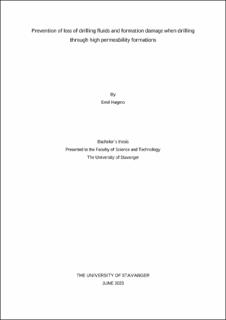| dc.description.abstract | In order to avoid kicks and the potential for a well blowout, it is necessary to maintain the drilling fluid pressure above the pore pressure of the formation. However, doing so may result in fluid loss due to the fluid being forced into the porous formation and, in some cases, lost circulation caused by excessive pressure that surpasses the formations fracturing pressure. In both scenarios, fluid can migrate into the formation, potentially causing damage.
Fluid loss is an essential aspect of drilling fluids used in the drilling process. Fluid loss refers to the amount of fluid that gets lost or absorbed into the formation while drilling, which can lead to damage to the formation, inability to control pressure, and a reduction in the effectiveness of the drilling fluid. Inadequate control of fluid loss during drilling can lead to decreased productivity, cost overruns, and environmental issues. The drilling fluids ability to reduce fluid loss is an essential factor in maintaining wellbore stability, controlling formation pressures, and avoiding lost circulation problems. To prevent excessive fluid loss, drilling fluids are designed to form a filtercake on the formation's surface, which helps control the fluid loss rate and prevent the formation from being damaged. This filtercake is formed by fine particles of the drilling fluid that get deposited on the surface of the formation, creating a barrier that restricts the fluid loss rate. The amount of fluid loss depends on several factors such as the permeability of the formation, the type of drilling fluid used, the temperature and pressure conditions, and the drilling speed. To maintain optimal drilling conditions, it is crucial to monitor fluid loss and adjust the drilling fluid properties accordingly.
The main focus of this study was to evaluate the relationship between the fluid loss of different drilling fluids following HTHP tests, and an analysis of the respective filtrate that could potentially cause formation damage. An analysis of the filtrate following fluid loss tests, could provide important rheological data that would give extended knowledge of the drilling fluid properties and capabilities. An alternative method for analyzing the fluid filtrate was used for this research. By flowing the filtrate through a needle, the viscosity was calculated at different shear rates. The results show how both spurt loss and overall fluid loss filtrate behaves after both filter paper, and ceramic disc fluid loss tests | |
